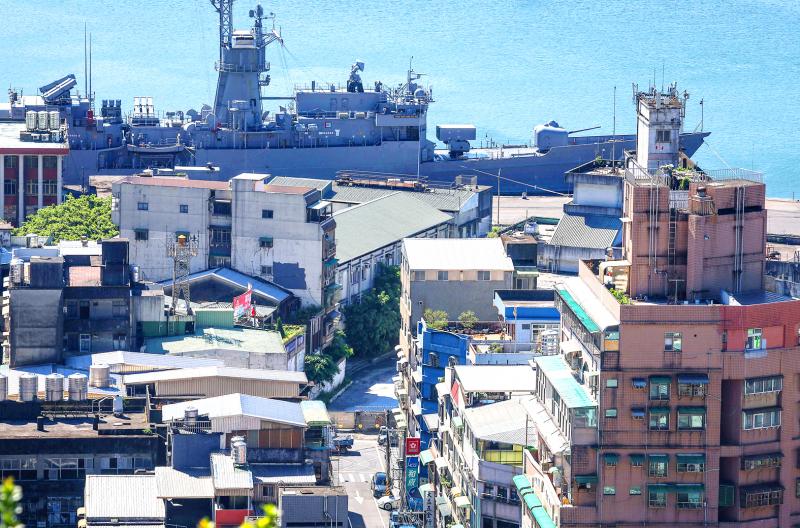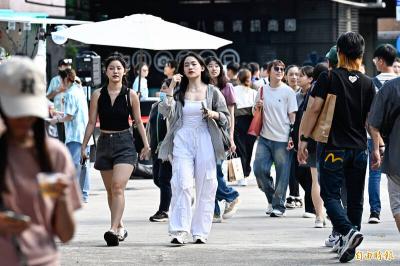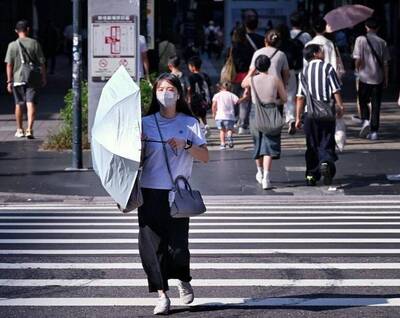Beijing’s largest-ever exercises around Taiwan have offered essential clues into its plans for a grueling blockade in the event of an attack on Taiwan, and revealed an increasingly emboldened Chinese military, experts said.
The visit to Taiwan by US House of Representatives Speaker Nancy Pelosi — second in line to the presidency — sparked outrage from Beijing, which launched vast military maneuvers around the nation, even at the risk of partially exposing its plans to the US and its Asian allies.
Mobilizing fighter planes, helicopters and warships, the drills aim to simulate a blockade of Taiwan and include practicing an “attack on targets at sea,” Chinese state news agency Xinhua said.

Photo: CNA
It is the first time Chinese exercises have taken place so close to Taiwan, with some of the drills happening less than 20km from the coast.
Also unprecedented are Beijing’s drills on Taiwan’s eastern flank, a strategically vital area for supplies to Taiwan’s military, as well as any potential US reinforcements.
A “blockade scenario” was long speculated to be one of China’s preferred strategies were it to try to conquer Taiwan, and this week’s drills have revealed how that might occur.
Such a siege would aim to prevent any entry or exit of commercial or military ships and aircraft. It would also deny US forces stationed in the region access to Taiwan.
The Chinese military “obviously has all the capabilities to impose such a blockade,” independent Chinese military analyst Song Zhongping (宋忠平) said.
The Chinese military fired a dozen ballistic missiles on Thursday that hit various areas around Taiwan, with some flying over Taipei, Beijing’s state broadcaster CCTV said on Friday.
Xinhua said that Beijing has mobilized more than 100 planes, and more than 10 frigates and destroyers, including the J-20 stealth fighter and a Type 055 destroyer, the crown jewels of China’s air and naval forces.
The exercises also make it possible to test and sharpen the level of coordination between the mobilized army corps — land, sea, air and rocket forces, as well as strategic support, tasked with cyberwarfare.
It is also a crucial test for the recently inaugurated Eastern Theater of Operations of the Chinese army, created in 2016, and which oversees the country’s entire eastern maritime space, in which Beijing includes Taiwan.
What China has done so far demonstrates its “robust capabilities,” Australian National University international security professor John Blaxland said.
“They can’t be dismissed as some kind of less inexperienced, incapable force,” he said. “They clearly have the ability to coordinate their land and sea, they have the ability to deploy missile systems, and they function effectively.”
“The converse, of course to this is that what they are doing is being closely studied and monitored for lessons to be learned by Taiwan, the United States, Japan and others,” Blaxland said.
During the Taiwan Strait crisis of 1995 and 1996, the US Navy transited several warships through the waterway and deployed aircraft carriers near the nation.
This time, however, “the US government is taking prudent steps to avoid unwanted escalation,” said Lonnie Henley, a former US intelligence officer and professor at the Elliott School of International Studies in Washington.
Caution is also rooted in the fact that China has greatly increased its military capabilities since 1996, when it was unable to deny the US Navy access to the area, he said.
“In some areas, the PLA [Chinese People’s Liberation Army] might even surpass US capabilities,” said Grant Newsham, a former US Navy officer and researcher at the Japan Forum for Strategic Studies.
“If the battle is confined to the area right around Taiwan, today’s Chinese navy is a dangerous opponent, and if the Americans and Japanese do not intervene for some reason, things would be difficult for Taiwan,” he said.
Chinese incursions across the so-called median line between Taiwan and China — never recognized by Beijing — also speak to a growing confidence, experts said.
“China has not felt comfortable to push its claims on the median line until recently,” Blaxland said. “We can expect them to continue to operate as if the median line is not valid. That’s been the case for a while, but it’s now accelerating.”

Three Taiwanese airlines have prohibited passengers from packing Bluetooth earbuds and their charger cases in checked luggage. EVA Air and Uni Air said that Bluetooth earbuds and charger cases are categorized as portable electronic devices, which should be switched off if they are placed in checked luggage based on international aviation safety regulations. They must not be in standby or sleep mode. However, as charging would continue when earbuds are placed in the charger cases, which would contravene international aviation regulations, their cases must be carried as hand luggage, they said. Tigerair Taiwan said that earbud charger cases are equipped

Foreign travelers entering Taiwan on a short layover via Taiwan Taoyuan International Airport are receiving NT$600 gift vouchers from yesterday, the Tourism Administration said, adding that it hopes the incentive would boost tourism consumption at the airport. The program, which allows travelers holding non-Taiwan passports who enter the country during a layover of up to 24 hours to claim a voucher, aims to promote attractions at the airport, the agency said in a statement on Friday. To participate, travelers must sign up on the campaign Web site, the agency said. They can then present their passport and boarding pass for their connecting international

Temperatures in northern Taiwan are forecast to reach as high as 30°C today, as an ongoing northeasterly seasonal wind system weakens, the Central Weather Administration (CWA) said. CWA forecaster Tseng Chao-cheng (曾昭誠) said yesterday that with the seasonal wind system weakening, warmer easterly winds would boost the temperature today. Daytime temperatures in northern Taiwan and Yilan County are expected to range from 28°C to 30°C today, up about 3°C from yesterday, Tseng said. According to the CWA, temperature highs in central and southern Taiwan could stay stable. However, the weather is expected to turn cooler starting tonight as the northeasterly wind system strengthens again

Taiwan sweltered through its hottest October on record, the Central Weather Administration (CWA) said yesterday, the latest in a string of global temperature records. The main island endured its highest average temperature since 1950, CWA forecaster Liu Pei-teng said. Temperatures the world over have soared in recent years as human-induced climate change contributes to ever more erratic weather patterns. Taiwan’s average temperature was 27.381°C as of Thursday, Liu said. Liu said the average could slip 0.1°C by the end of yesterday, but it would still be higher than the previous record of 27.009°C in 2016. "The temperature only started lowering around Oct. 18 or 19